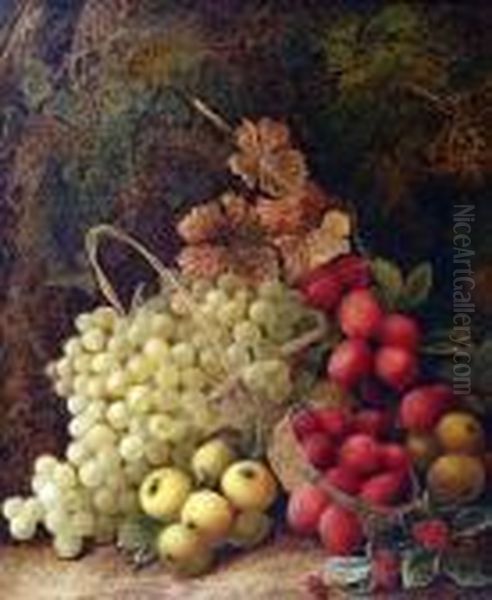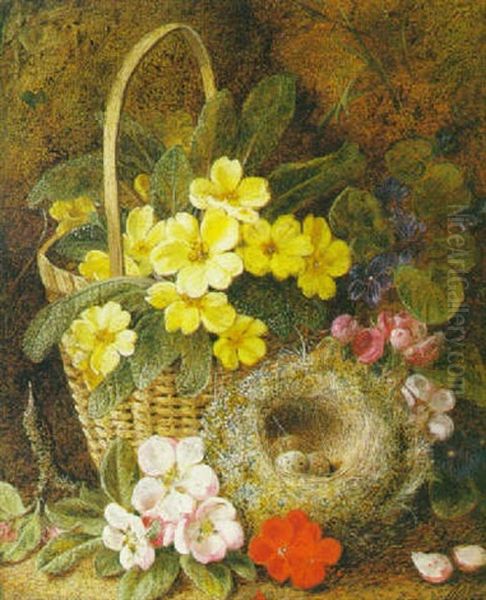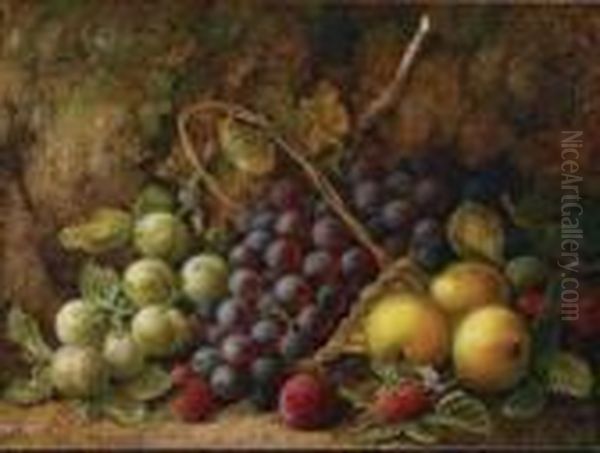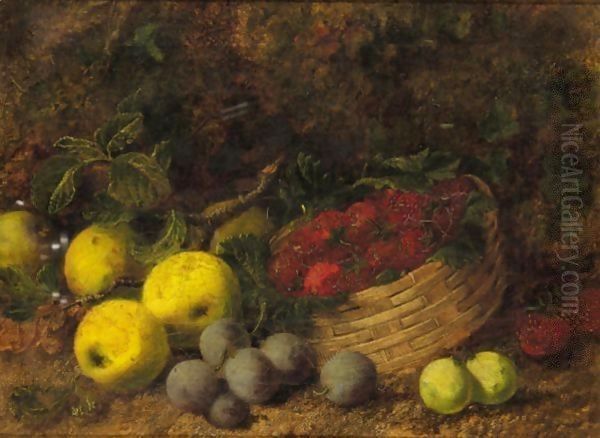George Clare stands as a significant figure within the rich tapestry of British Victorian art. Active during the latter half of the 19th century, he carved a distinct niche for himself as a painter renowned for his exquisitely detailed still-life compositions, particularly focusing on fruits and flowers. Though perhaps not as widely known today as some of his contemporaries who tackled grander historical or narrative themes, Clare's work continues to charm collectors and art enthusiasts with its technical brilliance and intimate portrayal of nature's bounty. His paintings serve as jewel-like windows into the Victorian appreciation for the natural world, rendered with a patience and precision that demands close attention.
Living and working primarily outside the bustling London art scene for much of his life, Clare developed a distinctive style that, while influenced by prevailing trends, retained a unique character. His legacy is not only preserved in his own canvases but also extended through his sons, who followed in his artistic footsteps, creating a small dynasty dedicated to the art of still life. This exploration delves into the life, technique, influences, and legacy of George Clare, placing him within the context of his time and celebrating his contribution to British art history.
Life and Career Beginnings
George Clare was born around 1830, although some sources suggest a slightly later date like 1835. Much of his life was spent away from the major metropolitan art centres, with a significant period residing in Barnet, Hertfordshire. It was in Barnet that he eventually passed away in 1900 (though some records suggest 1894, 1900 is often cited). Unlike many prominent artists of his era, details regarding Clare's formal artistic training remain obscure. There is no definitive record of him attending the prestigious Royal Academy Schools or studying under a specific well-known master.

This lack of documented training suggests he may have been largely self-taught or received instruction locally. Regardless of his educational path, Clare developed formidable technical skills. His public emergence as an artist seems to have occurred in the 1860s. Records indicate that his works began appearing in exhibitions during this decade, gaining particular notice initially in Birmingham, a thriving industrial city with a growing appetite for art and culture.
His choice of residence in Barnet, then a town on the outskirts of London, might have offered him proximity to nature, a constant source of inspiration for his work, while still allowing access to exhibition venues. His life appears to have been relatively quiet, focused on the meticulous creation of his art rather than engagement in the often-turbulent social circles of the London art world.
The Pervasive Influence of William Henry Hunt
To understand George Clare's artistic style, it is essential to acknowledge the profound influence of William Henry Hunt (1790-1864). Hunt was an immensely popular watercolourist, celebrated for his highly detailed and often charmingly rustic still lifes of fruit, flowers, bird's nests, and occasionally figures. Hunt's technique was characterized by its incredibly fine detail, achieved through a combination of transparent washes and, crucially, a method of stippling or applying dense dots and tiny strokes of opaque bodycolour (gouache) over the watercolour base.
This stippling technique allowed Hunt to render the varied textures of nature with astonishing realism – the downy bloom on a peach, the delicate translucency of grapes, the intricate structure of a bird's nest, or the velvety softness of moss. His works were admired by critics like John Ruskin, the influential Victorian art theorist who championed 'truth to nature', although Ruskin also sometimes critiqued Hunt's focus on the purely picturesque.
George Clare clearly absorbed Hunt's approach. Clare’s own use of a stippling technique, often referred to using the French term 'pointillé' (though distinct from the later Neo-Impressionist Pointillism of artists like Georges Seurat), is directly traceable to Hunt's methods. Clare adapted this technique primarily for oil painting, using fine brushes to build up surfaces with tiny touches of colour, achieving similar effects of texture and luminosity that Hunt managed in watercolour. This connection is a defining characteristic of Clare's work.
Artistic Style: Subject Matter and Composition

George Clare dedicated his career almost exclusively to still life painting. His preferred subjects were drawn directly from the natural world, rendered with an intimacy that suggests close observation. Fruit and flowers dominate his oeuvre. He excelled at depicting clusters of grapes, plums, peaches, apples, pears, and berries, often shown nestled amongst leaves or spilling invitingly from baskets. The way he captured the bloom on grapes or the fuzzy skin of a peach demonstrates his mastery of texture.
Flowers were another favourite subject. Clare painted garden varieties like roses, primroses, fuchsias, and pansies, as well as wildflowers. These were frequently arranged naturally, appearing as if freshly gathered and placed on a mossy bank or woodland floor. Bird's nests, often containing delicately speckled eggs, were also a recurring motif, echoing a popular theme in Victorian art that combined natural history interest with sentimental appeal.
Clare's compositions are typically small in scale and possess a sense of closeness. He often favoured naturalistic settings for his arrangements rather than formal tabletops. Mossy banks, earthy patches, or simple, shadowed backgrounds serve to highlight the textures and colours of the primary subjects. This approach lends his work an unpretentious, almost rustic charm, setting it apart from the more opulent still lifes of, for example, the earlier Dutch Golden Age masters like Jan van Huysum or Rachel Ruysch, or the more formal arrangements of some of his own contemporaries.
Technique: Meticulous Detail and Texture
The hallmark of George Clare's technique is his meticulous attention to detail, largely achieved through his distinctive stippling method. Using fine brushes, he applied small dots and dashes of oil paint to build up surfaces, creating incredibly nuanced representations of texture. This is evident in the soft, velvety surfaces of moss, the delicate transparency of grape skins, the powdery bloom on plums, and the intricate vein patterns on leaves and petals.
His application of paint was precise and controlled, resulting in a highly finished surface where individual brushstrokes often merge into a seamless whole when viewed from a normal distance. Up close, however, the intricate web of dots and touches becomes apparent, revealing the painstaking labour involved in their creation. This technique allowed him to capture the play of light on different surfaces effectively, giving his subjects a tangible, three-dimensional quality.

Clare's colour palette was generally bright and naturalistic, reflecting the vibrant hues of the fruits and flowers he depicted. He avoided overly dramatic contrasts or artificial lighting effects, preferring a clear, gentle light that illuminated his subjects evenly. While influenced by William Henry Hunt, Clare developed his own 'handwriting' within this detailed style, often achieving a slightly softer focus compared to the sometimes crystalline sharpness of Hunt's watercolours. It is important to differentiate Clare's stippling from the scientific Pointillism of French Neo-Impressionists like Georges Seurat and Paul Signac, which emerged later; Clare's technique was about rendering texture and detail, not about optical colour mixing theory.
Exhibition History and Recognition
George Clare actively exhibited his work during the peak years of his career, ensuring his paintings reached a public audience and potential patrons. His first documented exhibitions occurred in the 1860s, with Birmingham being a notable early venue. This suggests he may have had connections or found early success within the Midlands art scene.
Crucially, Clare gained acceptance at major London exhibition venues. He exhibited works at the prestigious Royal Academy of Arts between 1864 and 1874. Consistent inclusion in the RA's annual summer exhibition was a significant mark of professional standing for a Victorian artist. While the provided source text mentions a "Best Exhibitor Award," specific named awards of this type were uncommon at the RA during that period; it's more likely his work was well-received and prominently displayed, achieving recognition through its regular acceptance.
Clare also exhibited frequently at the Royal Society of British Artists (RBA), whose galleries were located on Suffolk Street. This venue was another important outlet for artists, often showcasing works slightly different in character from those favoured by the RA. His exhibition record also includes showings at other regional institutions, potentially including the Walker Art Gallery in Liverpool, indicating a broad reach beyond London and Birmingham. This consistent exhibition activity across multiple respected venues underscores his professional success and the appeal of his detailed still lifes during his lifetime.
Representative Works and Themes
While specific titles of George Clare's most famous works are not always consistently recorded or highlighted in the same way as narrative paintings, his output is recognizable through recurring themes and compositions. Many of his paintings carry descriptive titles assigned later, such as "Still Life of Fruit on a Mossy Bank," "Primroses and Bird's Nest," "Grapes, Plums and Raspberries," or "Mixed Flowers in a Natural Setting."

A typical Clare composition might feature a small cluster of fruit – perhaps purple and green grapes, a downy peach, and some raspberries – nestled amongst vibrant green moss and autumn leaves, set against a dark, earthy background. Another common arrangement involves a bird's nest with pale blue or speckled eggs, surrounded by primroses or violets, again often situated on a mossy bank, evoking the quiet beauty of the woodland floor.
These works encapsulate key Victorian sensibilities: a love for nature, an appreciation for detailed observation (spurred partly by interests in botany and natural history), and a certain domestic sentimentality. Clare's paintings offered intimate, jewel-like glimpses of nature's perfection, bringing the beauty of the outdoors into the Victorian home. They celebrate the transient beauty of fruit and flowers, capturing them at their peak ripeness or bloom with a fidelity that continues to attract admirers. His focus remained consistently on these small corners of the natural world, rendered with unwavering dedication.
The Clare Family: An Artistic Legacy
George Clare's artistic influence extended directly to his own family. Two of his sons, Oliver Clare (c. 1853–1927) and Vincent Clare (1855–c. 1930), became successful painters in their own right, largely adopting their father's style and subject matter. They continued the tradition of painting highly detailed still lifes of fruit and flowers, often set against the characteristic mossy backgrounds.
Oliver Clare, in particular, achieved considerable recognition and exhibited widely, including numerous works (reportedly 39 paintings) at the Royal Society of Artists in Birmingham, suggesting strong ties to the region where his father had also found early success. Vincent Clare also worked in a very similar vein.
The stylistic similarities between George Clare and his sons Oliver and Vincent can sometimes make attribution challenging, especially for unsigned works. All three shared a preference for similar subjects, compositions, and the detailed stippling technique inherited from the Hunt tradition. However, connoisseurs sometimes note subtle differences in handling, colour, or compositional preferences. Regardless, the continuation of the style by his sons solidified the Clare name's association with this specific genre of Victorian still life painting, creating a small but distinct family legacy within British art.
Context: Victorian Still Life and Contemporaries
George Clare worked during a period when still life painting enjoyed considerable popularity in Britain. The Victorian era saw a burgeoning middle class with disposable income and a desire to decorate their homes with art. Detailed, naturalistic depictions of flowers, fruit, and nature resonated with Victorian tastes, which valued craftsmanship, sentiment, and the perceived moral virtues of the natural world, often influenced by the writings of John Ruskin.
Clare's work can be situated alongside other Victorian artists specializing in or contributing significantly to still life and detailed naturalism. His primary influence, William Henry Hunt, stands paramount. Other notable figures include George Lance (1802-1864), an earlier specialist in elaborate fruit compositions, and William Duffield (1816-1863), known for his fruit and dead game subjects.
Perhaps the closest stylistic parallels can be drawn with Edward Ladell (1821-1886) and his wife Ellen Ladell (fl. 1886-1898), who painted fruit and objects like glasses of wine with a similar high degree of finish and realism, though often on more conventional tabletop settings. Myles Birket Foster (1825-1899), while primarily known for idyllic rural landscapes and genre scenes, shared a meticulous watercolour technique that echoed the detailed approach seen in still life.
Furthermore, the broader Pre-Raphaelite movement, with key figures like John Everett Millais and William Holman Hunt, championed intense observation and detailed rendering of nature, even when applied to larger narrative or symbolic works. Their emphasis on 'truth to nature' undoubtedly contributed to the climate in which detailed still life painting like Clare's could flourish. Comparing Clare to French contemporaries like Henri Fantin-Latour (1836-1904), known for his looser, more atmospheric flower paintings, highlights the distinctly detailed and textured quality of Clare's British Victorian approach.
Enduring Appeal and Market Presence
Despite the shifts in artistic taste over the past century, the work of George Clare has maintained a consistent appeal, particularly within the art market. His paintings are frequently found at auctions and in commercial galleries specializing in Victorian art. Their decorative quality, combined with the evident technical skill, makes them attractive to collectors seeking traditional, finely executed paintings for the home.
The relatively small scale of most of his works also makes them suitable for domestic settings. The subjects – familiar fruits, flowers, and bird's nests – possess a timeless charm that transcends the specific historical context of their creation. The meticulous detail invites close looking, offering a sense of wonder at the artist's ability to replicate nature so faithfully.
However, the very success of his style, and its continuation by his sons Oliver and Vincent, does create challenges in the market regarding attribution. Works simply signed "Clare" can sometimes be difficult to assign definitively to George, Oliver, or Vincent without careful stylistic analysis or provenance research. Nevertheless, works confidently attributed to George Clare, particularly well-preserved examples showcasing his signature stippling technique and vibrant colours, command respectable prices and are sought after by enthusiasts of Victorian still life.
Conclusion: A Dedicated Vision
George Clare represents a specific, yet significant, strand within Victorian art. He was not an innovator in the mould of the Impressionists or the Pre-Raphaelite Brotherhood's more radical members, but rather a dedicated and highly skilled practitioner working within an established tradition, which he refined to a remarkable degree. His life's work was devoted to the close observation and meticulous rendering of nature's small, often overlooked beauties – the bloom on a grape, the texture of moss, the delicate structure of a flower petal or a bird's nest.
Strongly influenced by William Henry Hunt, Clare translated Hunt's detailed watercolour techniques into the medium of oil paint, creating works characterized by their intricate stippling, vibrant naturalism, and intimate compositions. He found success in his lifetime, exhibiting regularly at major venues like the Royal Academy and the Royal Society of British Artists, and his appeal endures today among collectors who value craftsmanship and the quiet charm of Victorian still life.
While overshadowed by artists with grander ambitions, George Clare's legacy lies in his consistent dedication to his chosen genre and the exceptional skill he brought to it. His paintings, along with those of his sons Oliver and Vincent, offer a delightful window into the Victorian fascination with the natural world, captured with a precision and sensitivity that continue to captivate viewers more than a century after his death. He remains a respected master of floral and fruit painting within the British school.